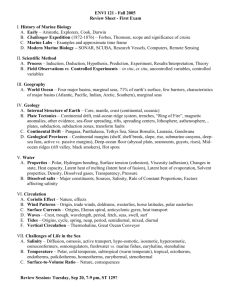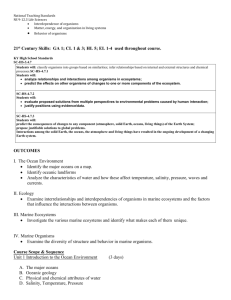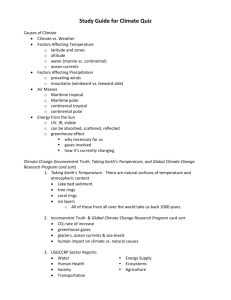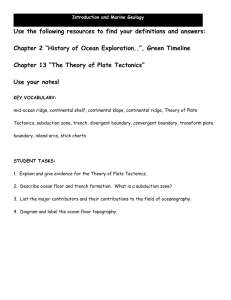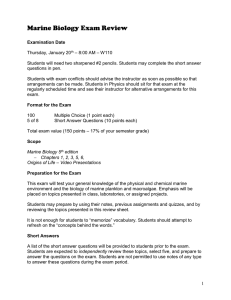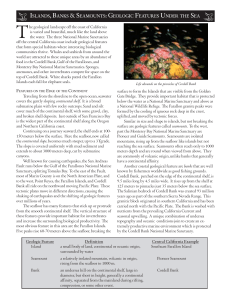Final Exam Review
advertisement
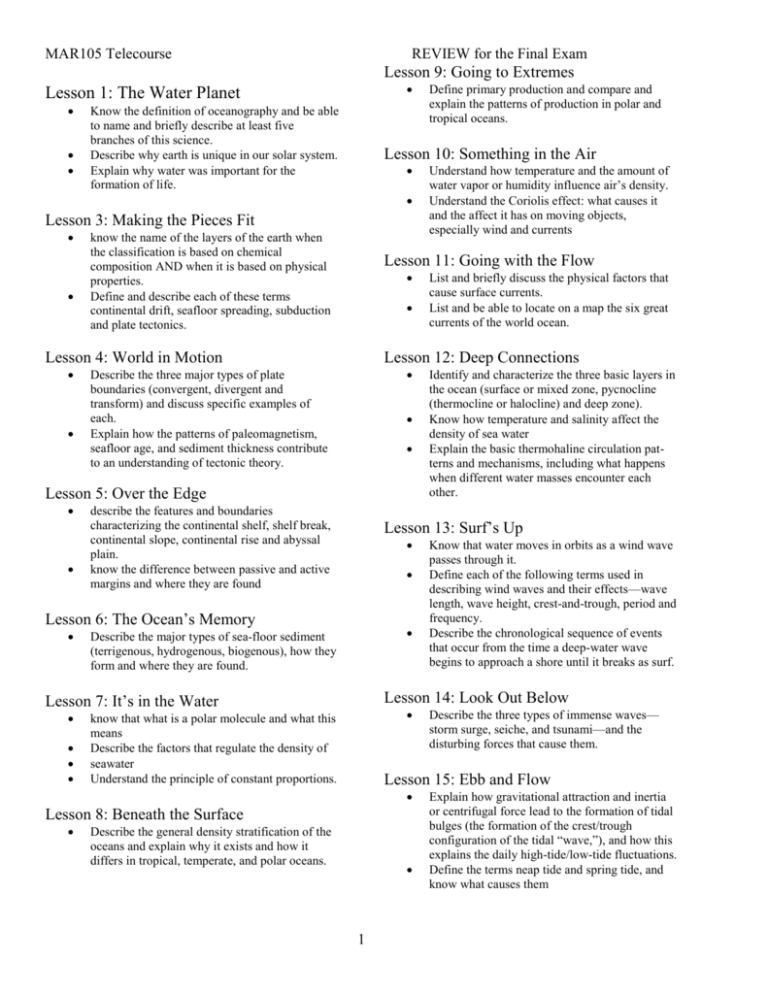
MAR105 Telecourse REVIEW for the Final Exam Lesson 9: Going to Extremes Lesson 1: The Water Planet Know the definition of oceanography and be able to name and briefly describe at least five branches of this science. Describe why earth is unique in our solar system. Explain why water was important for the formation of life. Lesson 10: Something in the Air Lesson 3: Making the Pieces Fit know the name of the layers of the earth when the classification is based on chemical composition AND when it is based on physical properties. Define and describe each of these terms continental drift, seafloor spreading, subduction and plate tectonics. describe the features and boundaries characterizing the continental shelf, shelf break, continental slope, continental rise and abyssal plain. know the difference between passive and active margins and where they are found Describe the major types of sea-floor sediment (terrigenous, hydrogenous, biogenous), how they form and where they are found. Lesson 7: It’s in the Water Know that water moves in orbits as a wind wave passes through it. Define each of the following terms used in describing wind waves and their effects—wave length, wave height, crest-and-trough, period and frequency. Describe the chronological sequence of events that occur from the time a deep-water wave begins to approach a shore until it breaks as surf. Lesson 14: Look Out Below know that what is a polar molecule and what this means Describe the factors that regulate the density of seawater Understand the principle of constant proportions. Describe the three types of immense waves— storm surge, seiche, and tsunami—and the disturbing forces that cause them. Lesson 15: Ebb and Flow Lesson 8: Beneath the Surface Identify and characterize the three basic layers in the ocean (surface or mixed zone, pycnocline (thermocline or halocline) and deep zone). Know how temperature and salinity affect the density of sea water Explain the basic thermohaline circulation patterns and mechanisms, including what happens when different water masses encounter each other. Lesson 13: Surf’s Up Lesson 6: The Ocean’s Memory List and briefly discuss the physical factors that cause surface currents. List and be able to locate on a map the six great currents of the world ocean. Lesson 12: Deep Connections Describe the three major types of plate boundaries (convergent, divergent and transform) and discuss specific examples of each. Explain how the patterns of paleomagnetism, seafloor age, and sediment thickness contribute to an understanding of tectonic theory. Lesson 5: Over the Edge Understand how temperature and the amount of water vapor or humidity influence air’s density. Understand the Coriolis effect: what causes it and the affect it has on moving objects, especially wind and currents Lesson 11: Going with the Flow Lesson 4: World in Motion Define primary production and compare and explain the patterns of production in polar and tropical oceans. Describe the general density stratification of the oceans and explain why it exists and how it differs in tropical, temperate, and polar oceans. 1 Explain how gravitational attraction and inertia or centrifugal force lead to the formation of tidal bulges (the formation of the crest/trough configuration of the tidal “wave,”), and how this explains the daily high-tide/low-tide fluctuations. Define the terms neap tide and spring tide, and know what causes them MAR105 Telecourse REVIEW for the Final Exam Lesson 23: Living Together Lesson 16: On the Coast Describe the major points of controversy and discussion relating to human interaction with beaches (such as building groins, seawalls, jetties and importing sand) and some of the possible management solutions and strategies. NEW LESSONS: Lesson 24: Treasure Trove Lesson 17: Due West There will be no questions about this lesson Lesson 18: Building Blocks Give some possible definitions of life Outline the theory of evolution by natural selection Lesson 19: Water World Define osmosis and discuss its importance to life in the sea. Discuss the relationships between viscosity and movement. Explain some adaptations organisms have to deal with this problem. Lesson 20: Food for Thought Define the term primary production and describe its importance to marine ecosystems. Compare how light and nutrients interact to produce the general seasonal patterns of primary production in tropical, temperate, and polar oceans. Describe Earth’s earliest life forms, and how they got their energy. Define the term invertebrate as it is used to describe groups of animals, both living and fossil. Describe the rocky intertidal zone of the marine environment—what physical conditions prevail there, and how the organisms that live there survive. Lesson 22: Life Goes On Be able to define and distinguish among marine physical, biological, energy, and nonextractive resources and give several examples of each. know how to define maximum sustainable yield and how this is used to try to manage fisheries Know how we define overfishing and examples, like the orange roughy, that have been fished to near extinction and know what countries take the most fish Know what bykill or bycatch is and what type of gear leads to large amounts of it (drift nets become ghost nets, trawling, purse seining) Know what marine sanctuaries are and how they are a relatively new method to protect fish populations. Be able to define and compare aquaculture, mariculture, and marine ranching and know examples of species that are grown in each way. Know some of the problems associated with mariculture Lesson 25: Dirty Water Lesson 21: Survivors Define ecology and ecological community and relate the terms niche, habitat, and biodiversity to the study of communities. Describe the three features of the chordate body plan Describe the three classes of fishes. Discuss the general characteristics of the class Mammalia and discuss four features shared by marine mammals. 2 know examples of sources of oil pollution and which source does most oil pollution come from know what habitats and organisms are particularly affected by oil pollution and why. Know some methods that are used to prevent and clean up oil spills Define and explain eutrophication, including the substances involved, their sources, and how organisms and habitats are affected. Be able to explain the concept of biological amplification or biomagnification using organic pollutants (such as DDT or PCBs) as an example. Know what ozone is and what chemicals caused its depletion, where the hole was the largest, and what the impact of ozone depletion is on organisms Be able to explain the greenhouse effect and how this leads to global warming Know what gases are greenhouse gases and where the gases come from Be able to describe why global warming leads to sea level rise and the impacts this will have on marine ecosystems. MAR105 Telecourse REVIEW for the Final Exam Be able to name ways to reduce the amount of CO2 in the atmosphere 3



